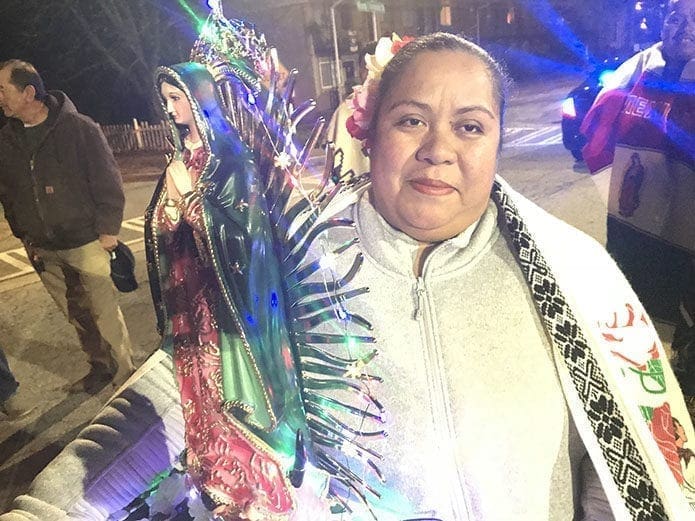 Photo by Andrew Nelson
Photo by Andrew NelsonHapeville
Our Lady of Guadalupe procession revived
By ANDREW NELSON, Staff Writer | Published December 19, 2018 | En Español
HAPEVILLE—A Mexican tradition displaying devotion and care to Our Lady of Guadalupe was revived in Hapeville, as scores of believers singing and praying aloud accompanied two dozen dancers in a Tuesday, Dec. 11 procession.
Women and men dancers wore feathered headdresses and traditional clothing. Keeping the beat with maracas, the dancers along the route would spin, stomp and make formations.
It has been more than four years since the joyful procession took to the streets, within sight of planes landing at Hartsfield-Jackson Atlanta International Airport.
“It was a beautiful emotion, the devotion the community has to Our Lady,” said Daniel Melendez, 40, who organized the revival. “It made the Hispanic community stronger.”
The Dec. 12 feast day commemorates the appearance of the Virgin Mary of Guadalupe to the peasant Juan Diego in 1531. Called the Queen of Mexico, Our Lady of Guadalupe is beloved by the Mexican community and is the patroness of the Americas.
In the Atlanta Archdiocese, the faithful flocked to parishes to celebrate the feast day with Mass, prayer, dancing and music. Hispanics make up about half of the 1.2 million Catholic community in the archdiocese.
The celebration at St. John the Evangelist Church started when the procession began at the Hapeville City Hall at 7 p.m. It made its way half a mile on King Arnold Street to the parish. People carried displays of the statue of the Virgin on their shoulders, along with banners and streamers. Police redirected traffic as they escorted believers. People stood on apartment balconies and in the entry of a laundromat to watch the procession pass. A standing-room only crowd of the faithful waited at the parish.
Churchgoers brought bouquets and vases of flowers to place in front of the image. Mass followed with prayers. People stayed at the church until 2 a.m.
Believers renewed the celebration again Wednesday afternoon. First, a mariachi band offered praise to the Virgin, followed by a rosary, Mass and a community potluck dinner.
Katherine Cruz was a first-time dancer in the Danza Guadalupana with its traditional Mexican routines. The 26-year-old said dancing was an “easy way for me to express my gratitude to Our Lady of Guadalupe for the intercession she does for us.”
Cruz was born in Ecuador but her husband is Mexican, so she has adopted the tradition.
She said she felt very close to the Virgin during the dancing. Cruz is pregnant with her second child and could feel the baby move. The experience was special as God “multiplies the blessing,” said Cruz, who is the Hispanic representative to the parish council.
The parish used the feast day to spur outreach. The parish sent seven statues of the Virgin into different neighborhoods. Parishioners hosted rosary and prayer events and invited neighbors to attend.
Jose Maya, 40, said he spoke to neighbors for the first time as he asked if they would like the Virgin statue to visit their homes. “She’s the mother. You never say ‘no,’” he said. “It’s good for the people to show the good tradition from Mexico.”
According to tradition, the Virgin of Guadalupe appeared to Juan Diego, an Aztec convert, on Dec. 9, 1531. Juan Diego’s vision of the Virgin occurred near the hill of Tepeyac, the site of a former Aztec temple. The Virgin instructed Juan Diego to visit the bishop of Mexico and requested that a shrine be built in her honor where she appeared. It would take Juan Diego three visits to convince the bishop and not until he returned with a cloak of roses. On Juan Diego’s final visit, Dec. 12, 1531, he presented his cloak, or tilma, to show the bishop the flowers. Opening the piece of clothing, a colorful image of the Virgin of Guadalupe was revealed.
The cloak with the image is displayed at the Basilica of Our Lady of Guadalupe in Mexico City, one of the most-visited shrines. She symbolizes motherhood, patriotism and Mexican identity.
Msgr. Dan Stack will lead a pilgrimage to Mexico City in 2019 to benefit The Georgia Bulletin. For details, go to bit.ly/GeorgiaMexico19